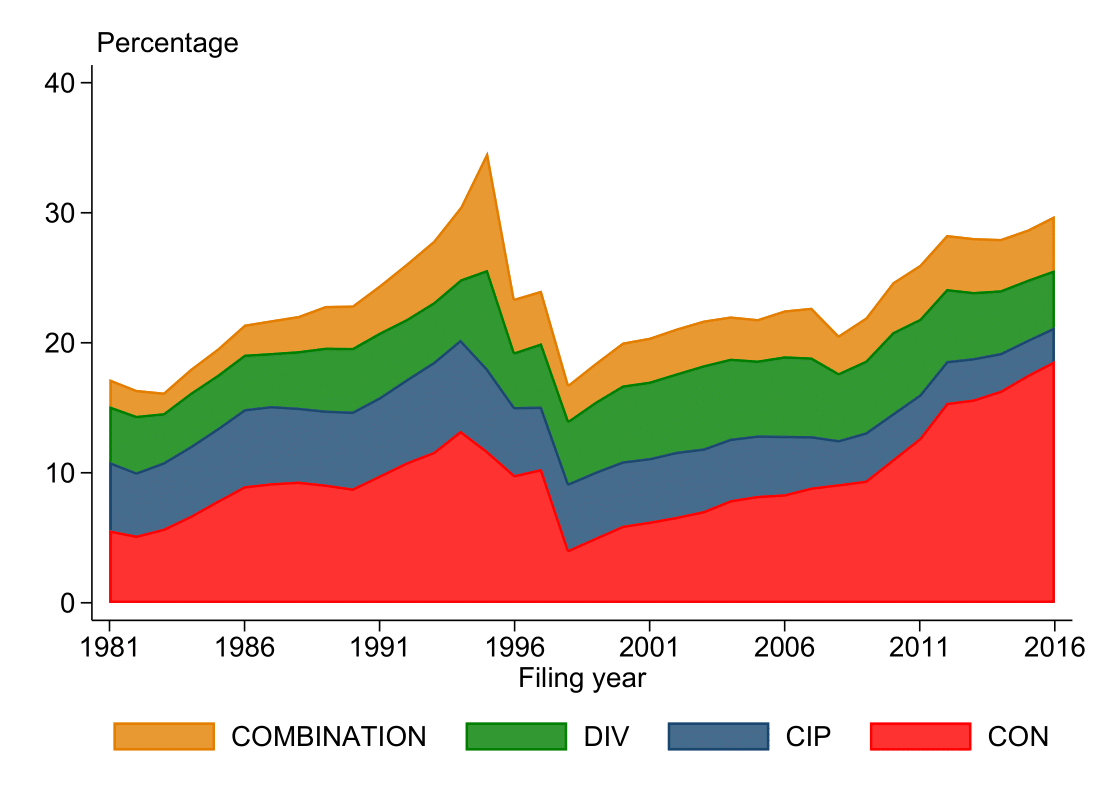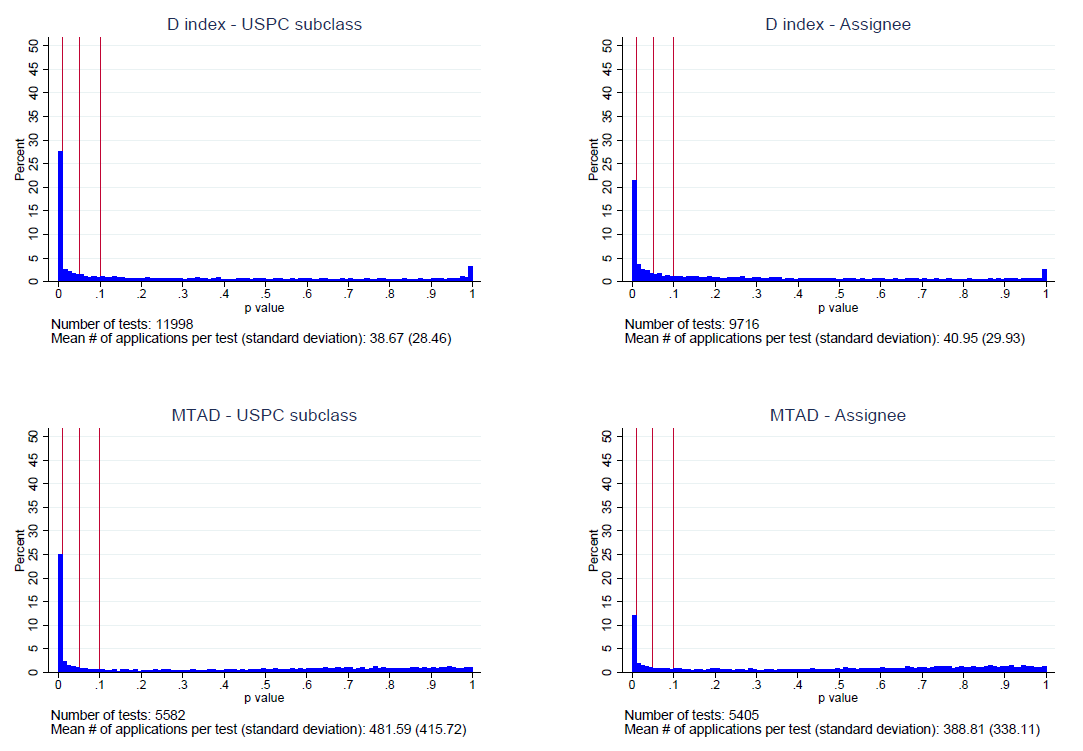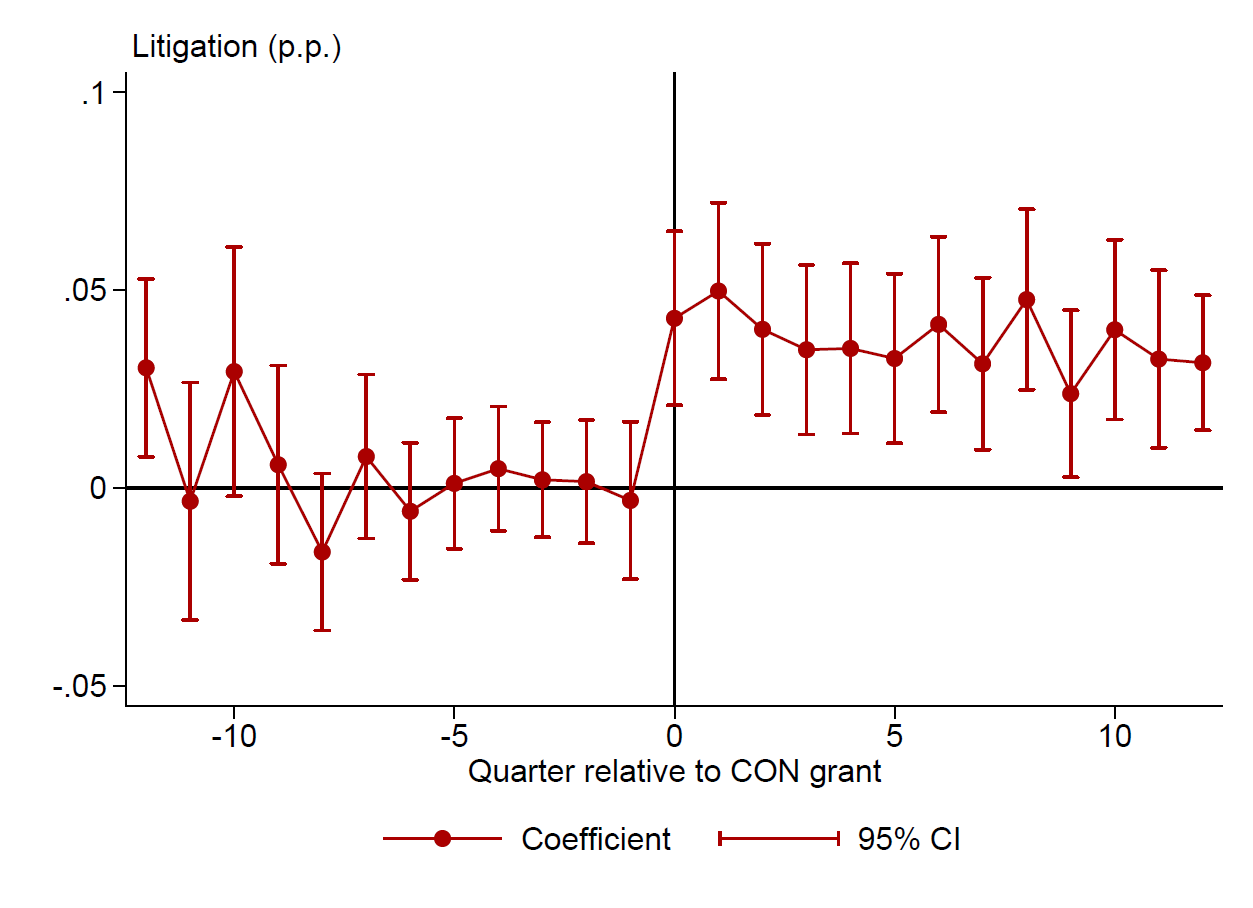ABOUT ME
I am an Assistant Professor in the Department of Economics and Business at Universitat Pompeu Fabra, and an Affiliated Professor of the Barcelona School of Economics and the UPF Barcelona School of Management. My research investigates topics in strategy, economics of innovation, intellectual property rights, and technology standards. I received my Ph.D. in Management (concentration in Strategy & Innovation) from Questrom School of Business, Boston University. Before joining UPF, I was a Postdoctoral Associate at the Technology & Policy Research Initiative, Boston University School of Law.
RESEARCH
Refereed Articles
Patenting Inventions or Inventing Patents? Continuation Practice at the USPTO (with Timothy Simcoe), RAND Journal of Economics, 54(3): 416--442, Fall 2023.
Continuations allow inventors to add new claims to old patents, leading to concerns about unintended infringement and holdup. We study how continuations are used in standard essential patent (SEP) prosecution. Difference in differences estimates suggest that continuation filings increase by 80%–121% after a standard is published. This effect is larger for applicants with licensing-based business models and for patent examiners with a higher allowance rate. Claim language is more similar for SEPs filed after standard publication, and late-filing is positively correlated with litigation. These findings suggest widespread use of continuations to draft patents that are infringed by already-published standards.
Previous versions of this paper circulated as NBER Working Paper No. 27686 and Barcelona School of Economics Working Paper 1320.
You can read a short summary of the paper on the TPRI website.
Allan Shampine reviewed this paper for The Antitrust Source. You can read his review here.
You can also find a short summary of the most recent version of the paper on the BSE Focus website.
Continuing Patent Applications at the USPTO (with Davide Cannito and Theodor Vladasel) Research Policy, 52(4), May 2023, 104742.
Despite their growing importance for firm innovation strategy and frequent appearance in U.S. patent policy debates, how continuing patent applications are used remains unclear. Turn-of-the-century reforms strongly limited opportunities to extend patent term and surprise competitors, but continuing applications have steadily risen since. We argue that they retain a subtle use, as applicants can file continuations to keep prosecution open and change patent scope after locking in gains with the initial patent. We document a sharp drop in parent abandonment and rise in continuations per original patent after the reforms. Continuing applications are more privately valuable than original patents, are filed in more uncertain contexts, for higher value technologies, by more strategic applicants, and react strongly to the notice of allowance. The evidence supports a current strategic use of continuing applications to craft claims over time.
Disclosure Rules and Declared Essential Patents (with Rudi Bekkers, Christian Catalini, Arianna Martinelli and Timothy Simcoe) Research Policy Volume 52(1), January 2023, 104618.
Many standard setting organizations (SSOs) require participants to disclose patents that might be infringed by implementing a proposed standard, and commit to license their ``essential'' patents on terms that are fair, reasonable and non-discriminatory (FRAND). Data from SSO intellectual property disclosures have been used in academic studies to provide a window into the standard setting process, and in legal proceedings to assess the relative contribution of different parties to a standard. We describe the disclosure process, discuss the link between SSO rules and patent-holder incentives, and analyze disclosure practices using a novel dataset constructed from the disclosure archives of thirteen major SSOs. Our empirical results suggest that subtle differences in SSO policies influence which patents are disclosed, the terms of licensing commitments, and ultimately long-run citation and litigation rates for the underlying patents. Thus, while policy debates sometimes characterize SSOs as a relatively homogeneous set of institutions, our results point in the opposite direction — towards the importance of recognizing heterogeneity in SSO policies and practices.
A previous version of this paper circulated as NBER Working Paper No. 23627.
The data on the declared essential patents that we use in this study are available here.
Patent Examiner Specialization (with Timothy Simcoe) Research Policy, 48(1): 137--148, February 2019.
We study the matching of patent applications to examiners at the U.S. Patent and Trademark Office. The distribution of technology classes is more concentrated than would occur under random matching and F-tests reject the hypothesis that family size and claim scope are randomly distributed across examiners. Using the application text, we show that examiner specialization persists even after conditioning on technology sub-classes. Specialization is less pronounced in computers and software than other technology fields. More specialized examiners have a lower grant rate. These findings undermine the idea that random matching justifies instrumental variables based on examiner behaviors or characteristics.
Link to most recent working paper version.
A previous version of this paper circulated as NBER Working Paper No. 23913.
Tim and I also wrote a short post for the blog of Dennis Crouch about the results in this paper. You can find the blog post here.
WORKING PAPERS
Continuation Patents and Litigation
Continuations allow patentees in the United States to modify the scope of previous patents, leading to concerns about patent disputes generated by changes in patent boundaries. I show that continuations are litigated more often than original patents, even after controlling for patent and invention characteristics. I also exploit the pre-grant publication of patent applications and the timing of continuation grant to show that continuation grant increases litigation. The effect is stronger when the textual distance between the claims of a continuation and those of its original patent is greater, suggesting larger changes in scope lead to more disputes.
Link to working paper version. Comments are welcome!
Information Technology and Firm Employment (with James Bessen)
Do firms displace labor with new information technologies such as “artificial intelligence”? It is challenging to distinguish the effects of technology adoption from unobserved productivity and demand shocks. We take a first look at the economic impacts of large custom software investment —“IT spikes”—using a novel methodology to obtain consistent estimates. Following these events, firm employment increases by about 7% and revenues by about 11%. Rather than displace labor, IT spikes increase revenues and markups, implying decreased labor share of output. Moreover, growth is greater for firms that use AI, IT-producing firms, newer firms, and those in the trade, service, and financial sectors.
Link to working paper version. Comments are welcome!
Standard setting organizations and the scope of cumulative inventive activity (with Timothy Simcoe)
In this paper we study the relationship between technology endorsement by Standard Setting Organizations (SSOs) and the direction of inventive activity. We develop a theoretical framework that combines the concepts of direct and indirect network effects with the insights of the literature on cumulative inventive activity to understand how SSOs shape the scope of inventive activity upon compatibility standards. We introduce the concepts of ``deepening'' (cumulative technical progress characterized by relatively low dispersion across technological areas) and ``broadening'' (cumulative technical progress characterized by relatively high dispersion across technological areas) and relate them to the activities of SSOs. In the empirical analysis, we exploit the disclosure of SEPs as a window on standardization within SSOs and compare the dispersion of patent citation flows to SEPs and similar patents. In the first part of the analysis we use a measure of patent-to-patent text similarity and a new measure that takes into account the probability of inter-class citation to estimate the balance between deepening and broadening. In the second part, we separate deepening and broadening using citations from technological classes that repeatedly cite a patent as a measure of deepening and citations from new classes as a measure of broadening. The results provide evidence that both trends are occurring. The overall pattern of results suggests that SSOs select technologies that are important in a relatively narrow technological area, and their adoption as input for following inventive activity broadens after standardization. We also explore the heterogeneity across SSOs and licensing terms and find substantial differences.
Please send me an email for the latest version of the paper.
Declining Industrial Disruption (with James Bessen, Erich Denk and Joowon Kim)
Recent research finds that markups are rising, suggesting declining competition. But does less price competition mean less Schumpeterian “creative destruction”/industry dynamism? This paper reports the first recent estimates of trends in the displacement of industry-leading firms. Displacement hazards rose for several decades since 1970 but have declined sharply since 2000. Using a production function-based model to explore the role of investments, acquisitions, and lobbying, we find that investments by dominant firms in intangibles, especially software, are distinctly associated with greater persistence and reduced leapfrogging. Software investments by top firms soared around 2000, contributing substantially to the decline. Also, higher markups are associated with greater displacement hazards, linking rents positively with industry dynamism. While technology is often seen as disrupting industry leaders, it now appears to help suppress disruption.
Link to working paper version. Comments are welcome!
chapters in books
Standards, patents and innovation (with Timothy Simcoe).
This chapter reviews the empirical literature on standards' role in cumulative innovation, with a particular emphasis on studies that exploit data collected from Standard Setting Organization (SSO) intellectual property disclosures. We begin by discussing the relationship between standards and intellectual property, and then turn to a series of topics that have been studied using data on disclosed patents. These topics include the role of SSOs in promoting technology diffusion and factors that influence the performance of SSOs. The chapter concludes by discussing several promising areas for future research.
This chapter was published in the Handbook of Standards and Innovation, Hawkins, R., Blind, K. and Page, R. (Eds.), Cheltenham: Edward Elgar Publishing. 2017.
teaching
UPF Barcelona School of Management
Technology Strategy (M.S., 2023)
Universitat Pompeu Fabra
Strategic Management II (undergraduate, 2023)
Global Business and Brand Management (undergraduate, 2021-2023)
contact
Universitat Pompeu Fabra
Department of Economics and Business
Carrer de Ramon Trias Fargas 25-27
Jaume I building, room 20.1E34
Barcelona, 08005, Spain








